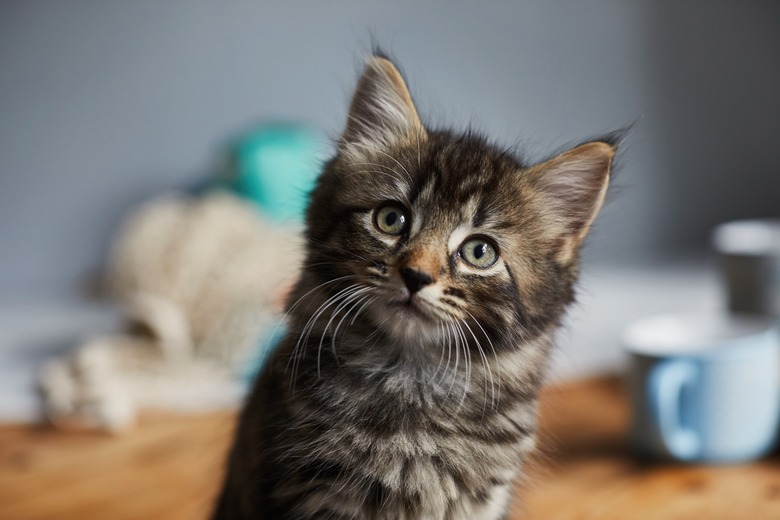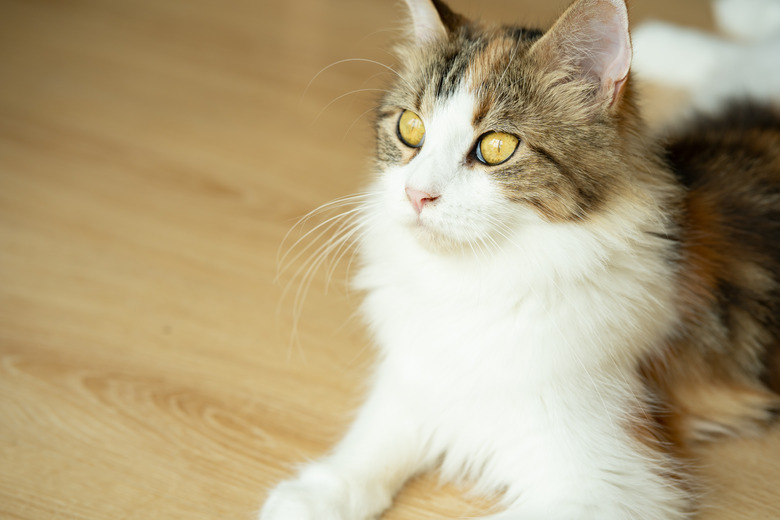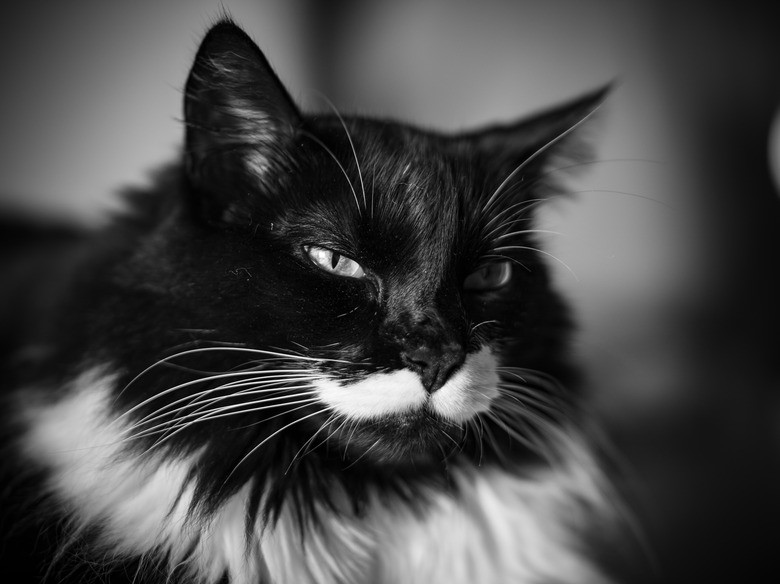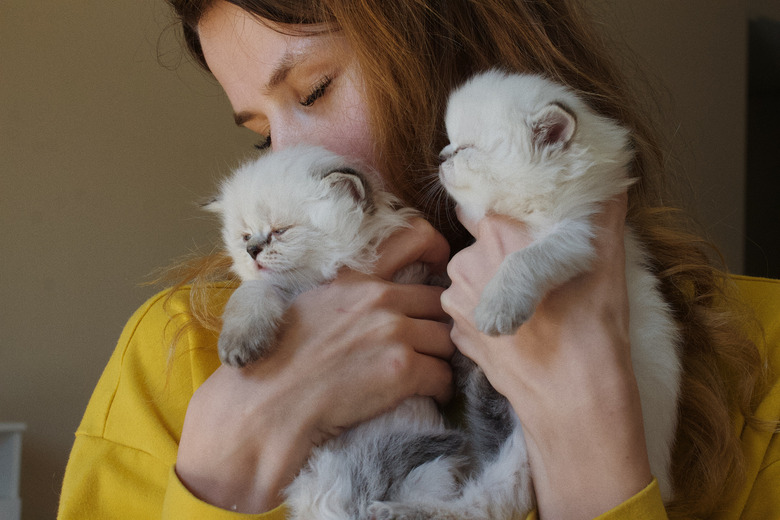Eye Discharge, Lethargy & Weakness In Felines
If a kitten or cat appears weak and lethargic and this is accompanied by eye discharge, it may be a sign of an infectious respiratory or other viral infection. Bacterial infections, fevers, abscesses, or allergens may also cause a cat or a kitten's eyes to appear watery, so a visit to the veterinarian may be needed to resolve the issue.
Symptoms of eye issues in cats
Symptoms of eye issues in cats
A cat's eyes should be clear and bright. If the cat shows the appearance of eye problems, such as runny eyes or excessive tearing; eye discharge; a dried, crusty substance around the eye; or swelling of the eye area, it may mean the cat has an eye infection. Other symptoms of an eye infection may include frequent blinking, tearing, squinting, pawing at the eye, or pinkness or redness in the eye. Eye infections can be painful for a cat and may require prescription eye drops or eye ointment.
Reasons for watery cat eyes
Reasons for watery cat eyes
There are many reasons a cat may have watery eyes. These can include allergies, infections, a foreign body stuck in the eye, or even a condition called entropion, where the cat's eyelid rolls inward, rubbing against the surface of the eye and causing irritation. Epiphora, which is an overflow of tears from the cat's eyes, may be caused by a blockage of the tear ducts. If there seems to be excessive tear production, a veterinarian can help to discover the underlying cause.
Conjunctivitis in cats
Conjunctivitis in cats
Conjunctivitis is the most common type of eye infection in felines. The conjunctiva is a thin membrane that lines the inner surface of a cat's eyelids and the outer surface of the eyeball. Humans have a conjunctiva as well and can also get this infection, often referred to as "pink eye."
In cats, the most common cause of conjunctivitis is a feline herpesvirus, but it can also be caused by bacteria. Sometimes, infections are mixed and include both viral and bacterial components.
Conjunctivitis in cats is usually easily treated. However, it's important for the cat to be examined by a veterinarian to ensure that there are no additional issues, such as corneal ulcers or other damage to the cornea or even a foreign object causing irritation in the eye.
Signs of cat flu
Signs of cat flu
Cat flu causes sneezing, wheezing, and watery eyes. While eye discharge often suggests an eye infection, a cat's watery eyes combined with a loss of appetite may mean more than just an ordinary eye infection. The cat may be suffering from "cat flu," which is a generic term for upper respiratory infections generally caused by either feline calicivirus, feline herpesvirus, or infections of both. Other causes for this type of illness may include coronaviruses, reoviruses, and bacterial infections.
Other common symptoms mimic those of the human flu: lethargy, not eating, fever, and runny nose. Cat flu may also be seen in cats who have been recently adopted from crowded animal shelters, as poorly ventilated environments and overcrowding can also contribute to cat flu.
If a cat is lethargic and not eating, has eye discharge, and has classic flulike symptoms, it is time to visit a veterinarian. It's also important to note that cats will often hide signs of illness, so sometimes, the signs that a cat is sick are subtle.
Cat's eyes watering and not eating
Cat's eyes watering and not eating
If a cat has watery eyes and has not eaten for 24 hours, the cat needs veterinary help as soon as possible. A cat who has not eaten is in danger of developing a life-threatening condition called hepatic lipidosis, or fatty liver disease. This may completely suppress a cat's appetite for weeks and requires extensive medical care for recovery.
Feline calicivirus is also a common condition in domestic and wild cats. It's not usually serious, although some strains can be life-threatening. Calicivirus is often seen in environments where there are many cats, such as a shelter, pet store, or cat breeder. It most commonly affects young cats. Infected cats' eyes can have discharge and be watery.
Most cats with feline calicivirus develop an upper respiratory tract infection. If the virus travels into the lungs, it can cause pneumonia. Symptoms can vary depending on which strain is affecting the cat, but if a cat is lethargic, is not eating, and has eye discharge, it could be calicivirus.
Basic symptoms mimic those of a cold: sneezing, nasal congestion, fever, sometimes drooling, and discharge from the eyes and nose. More severe infections can result in ulcers in the mouth along with lethargy and lack of appetite.
Lethargy and weakness in kittens
Lethargy and weakness in kittens
A kitten who is lethargic and seems weak or off balance could be falling victim to something called "fading kitten syndrome." Fading kitten syndrome is death that occurs in the weeks between birth and weaning. Kittens can show a variety of clinical symptoms. Factors that may contribute to fading kitten syndrome include low birth weight, congenital abnormalities, bacterial and viral infections, and incompatibility between the kitten's blood type and the mother's (a condition called neonatal isoerythrolysis). If this happens, they need medical care immediately.
Initial symptoms usually include eating poorly or a failure to gain weight. If a kitten is not eating and is lethargic and weak, rub sugar syrup on their gums and seek immediate veterinary care.
Kittens may also exhibit signs of lethargy, a cool body, trouble breathing, or meowing in distress. If these symptoms are evident, the kitten should be kept warm and taken to a veterinarian immediately.
The bottom line
The bottom line
A cat's eyes should appear clear and bright, not cloudy, runny, or red. Watery eyes, redness, or eye discharge may indicate an eye infection, such as conjunctivitis. If the cat also has cold-like symptoms, this may indicate a respiratory infection or "cat flu." If the cat has eye discharge, is lethargic, and is not eating, immediate veterinary care is required.



